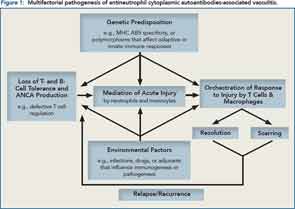“Another important issue for the clinicians,” she said, “is our ability to quantify disease burden and disease activity with noninvasive testing and identification upstream of pathogenic events.”
For Dr. Weyand, the new disease model demands a rethinking of the approach to assessment and treatment of large-vessel vasculitis, particularly as this condition occurs primarily in older patients. “Short and long term management of the disease has to take into account the age of the patient population,” she said, emphasizing the need to assess the risks of immunosuppression in elderly patients. “The majority of patients with GCA have a normal life expectancy, “she said. “Can long-term immunosuppression really improve the outcome, and can we do long-term immunosuppression with acceptable risk for side effects in an elderly patient population?”

Pathogenesis of Small-Vessel Vasculitis
Ronald Falk, MD, Allan Brewster Distinguished Professor of Medicine at the University of North Carolina in Chapel Hill, focused on three common clinical questions he hears from practicing physicians and patients with immune diseases:
- What is the cause of disease?
- What are the factors involved in disease pathogenesis?
- What causes a relapse or sustains remission?
Using data from a genome-wide study published in the New England Journal of Medicine, he discussed findings that suggest the pathogenesis of antineutrophil cytoplasmic antibody (ANCA)–associated vasculitis has a genetic component.1 In particular, the study shows that sets of genes associated with ANCA-associated vasculitis are not clustered according to the disease itself, but rather according to the type of ANCA (i.e., proteinase 3 [PR3] ANCA-associated vasculitis or myeloperoxidase [MPO] ANCA-associated vasculitis) suggesting two distinct autoimmune syndromes.
Along with genetic factors involved in the pathogenesis of disease, he also emphasized the influence of environmental factors that remain to be discovered. All of these factors play a role in why some patients relapse and others sustain a remission. He summarized the pathogenesis of ANCA vasculitis by citing an algorithm he and his colleagues have developed (see Figure 1).
Key Message to Clinicians
For practicing rheumatologists who see patients with small- and large-vessel vasculitis, a key message from this session, according to Dr. Hajj-Ali, is the crucial need to identify the pathogenic pathways in crafting therapeutic modalities. She emphasized the need to identify the triggers that initiate the inflammatory response, and the need for clinicians to recognize that the signature of chronic inflammation may not reflect the initial trigger response.
